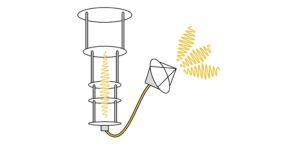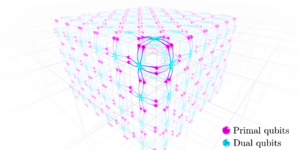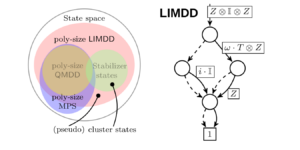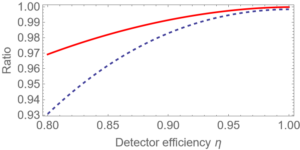PsiQuantum, Palo Alto
Find this paper interesting or want to discuss? Scite or leave a comment on SciRate.
Abstract
There are several models of quantum computation which exhibit shared fundamental fault-tolerance properties. This article makes commonalities explicit by presenting these different models in a unifying framework based on the ZX calculus. We focus on models of topological fault tolerance – specifically surface codes – including circuit-based, measurement-based and fusion-based quantum computation, as well as the recently introduced model of Floquet codes. We find that all of these models can be viewed as different flavors of the same underlying stabilizer fault-tolerance structure, and sustain this through a set of local equivalence transformations which allow mapping between flavors. We anticipate that this unifying perspective will pave the way to transferring progress among the different views of stabilizer fault-tolerance and help researchers familiar with one model easily understand others.
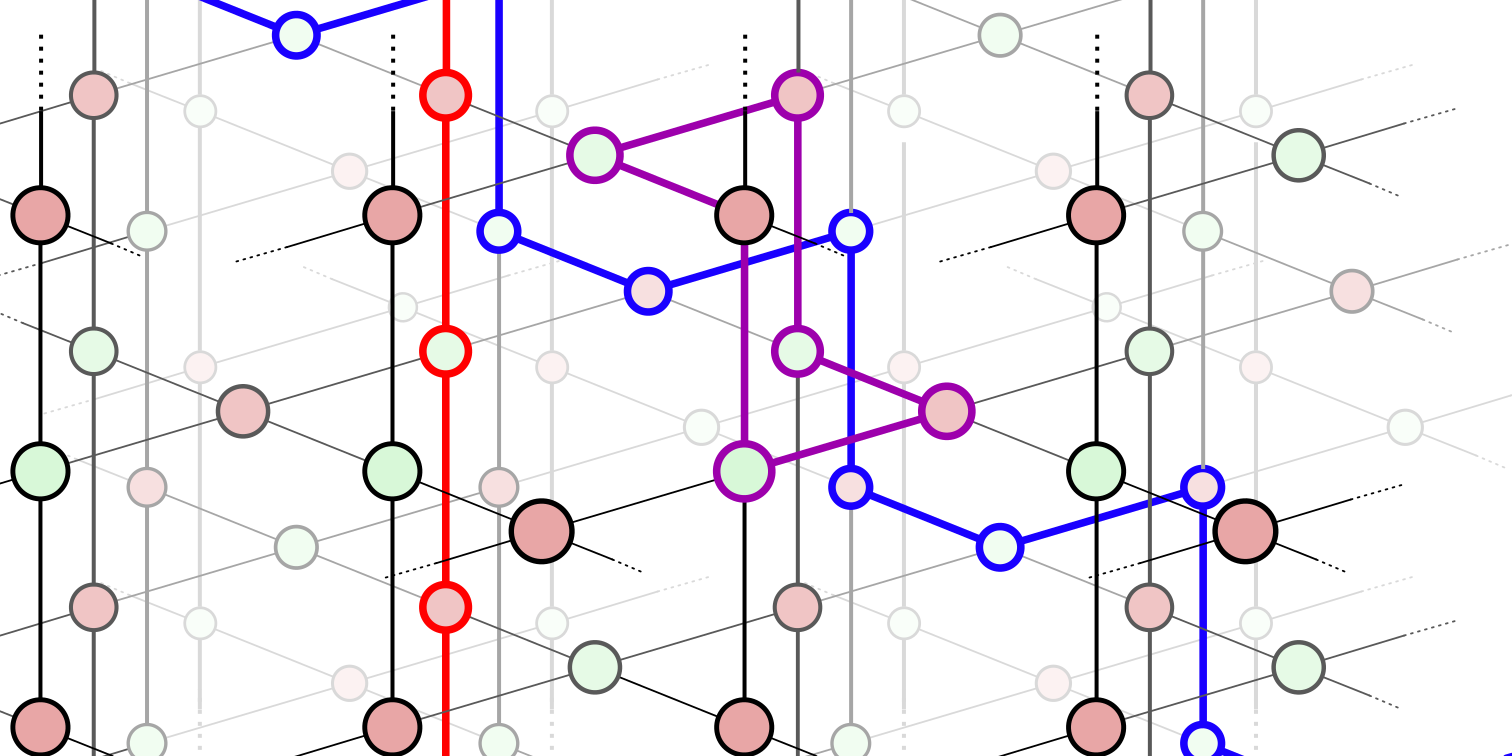
Featured image: The shared backbone of surface-code style stabilizer fault-tolerance is represented using the diagrammatic notation of the ZX calculus (graph with green and red nodes). Features specific to each compuational paradigm are highlighted such as physical qubit world-lines in the circuit model (red) or floquet model (blue) and resource states for fusion based model (purple).
Popular summary
► BibTeX data
► References
[1] Alexei Yu Kitaev. “Fault-tolerant quantum computation by anyons”. Annals of Physics 303, 2–30 (2003).
https://doi.org/10.1016/S0003-4916(02)00018-0
[2] Eric Dennis, Alexei Kitaev, Andrew Landahl, and John Preskill. “Topological quantum memory”. Journal of Mathematical Physics 43, 4452–4505 (2002).
https://doi.org/10.1063/1.1499754
[3] Robert Raussendorf, Daniel E. Browne, and Hans J. Briegel. “Measurement-based quantum computation on cluster states”. Physical Review A 68, 022312 (2003).
https://doi.org/10.1103/PhysRevA.68.022312
[4] H. J. Briegel, D. E. Browne, W. Dür, R. Raussendorf, and M. Van Den Nest. “Measurement-based quantum computation”. Nature Physics 2009 5:1 5, 19–26 (2009).
https://doi.org/10.1038/nphys1157
[5] R. Raussendorf, J. Harrington, and K. Goyal. “A fault-tolerant one-way quantum computer”. Annals of Physics 321, 2242–2270 (2006).
https://doi.org/10.1016/j.aop.2006.01.012
[6] Sara Bartolucci, Patrick Birchall, Hector Bombin, Hugo Cable, Chris Dawson, Mercedes Gimeno-Segovia, Eric Johnston, Konrad Kieling, Naomi Nickerson, Mihir Pant, et al. “Fusion-based quantum computation”. Nature Communications 14, 912 (2023).
https://doi.org/10.1038/s41467-023-36493-1
[7] Matthew B. Hastings and Jeongwan Haah. “Dynamically generated logical qubits”. Quantum 5, 564 (2021).
https://doi.org/10.22331/q-2021-10-19-564
[8] Adam Paetznick, Christina Knapp, Nicolas Delfosse, Bela Bauer, Jeongwan Haah, Matthew B. Hastings, and Marcus P. da Silva. “Performance of planar Floquet codes with Majorana-based qubits”. PRX Quantum 4, 010310 (2023).
https://doi.org/10.1103/PRXQuantum.4.010310
[9] Jeongwan Haah and Matthew B. Hastings. “Boundaries for the honeycomb code”. Quantum 6, 693 (2022).
https://doi.org/10.22331/q-2022-04-21-693
[10] Craig Gidney, Michael Newman, and Matt McEwen. “Benchmarking the planar honeycomb code”. Quantum 6, 813 (2022).
https://doi.org/10.22331/q-2022-09-21-813
[11] Craig Gidney. “A pair measurement surface code on pentagons”. Quantum 7, 1156 (2023).
https://doi.org/10.22331/q-2023-10-25-1156
[12] Markus S. Kesselring, Julio C. Magdalena de la Fuente, Felix Thomsen, Jens Eisert, Stephen D. Bartlett, and Benjamin J. Brown. “Anyon condensation and the color code”. PRX Quantum 5, 010342 (2024).
https://doi.org/10.1103/PRXQuantum.5.010342
[13] Ramón Aguado and Leo P. Kouwenhoven. “Majorana qubits for topological quantum computing”. Physics Today 73, 44 (2020).
https://doi.org/10.1063/PT.3.4499
[14] Héctor Bombín, Chris Dawson, Ryan V. Mishmash, Naomi Nickerson, Fernando Pastawski, and Sam Roberts. “Logical blocks for fault-tolerant topological quantum computation”. PRX Quantum 4, 020303 (2023).
https://doi.org/10.1103/PRXQuantum.4.020303
[15] Daniel Gottesman. “Opportunities and challenges in fault-tolerant quantum computation” arXiv:2210.15844 (2022).
https://doi.org/10.48550/arXiv.2210.15844
arXiv:2210.15844
[16] Bob Coecke and Ross Duncan. “Interacting quantum observables: categorical algebra and diagrammatics”. New Journal of Physics 13, 043016 (2011).
https://doi.org/10.1088/1367-2630/13/4/043016
[17] Miriam Backens. “The ZX-calculus is complete for stabilizer quantum mechanics”. New Journal of Physics 16, 093021 (2014).
https://doi.org/10.1088/1367-2630/16/9/093021
[18] Bob Coecke and Aleks Kissinger. “Picturing quantum processes: A first course in quantum theory and diagrammatic reasoning”. Cambridge University Press. (2017).
https://doi.org/10.1017/9781316219317
[19] Niel de Beaudrap and Dominic Horsman. “The ZX calculus is a language for surface code lattice surgery”. Quantum 4, 218 (2020).
https://doi.org/10.22331/q-2020-01-09-218
[20] Amar Hadzihasanovic, Kang Feng Ng, and Quanlong Wang. “Two complete axiomatisations of pure-state qubit quantum computing”. Proceedings – Symposium on Logic in Computer SciencePages 502–511 (2018).
https://doi.org/10.1145/3209108.3209128
[21] Emmanuel Jeandel, Simon Perdrix, and Renaud Vilmart. “A complete axiomatisation of the ZX-calculus for Clifford+T quantum mechanics”. Proceedings – Symposium on Logic in Computer SciencePages 559–568 (2018).
https://doi.org/10.1145/3209108.3209131
[22] John van de Wetering. “ZX-calculus for the working quantum computer scientist” arXiv:2012.13966 (2020).
https://doi.org/10.48550/arXiv.2012.13966
arXiv:2012.13966
[23] Tom Peham, Lukas Burgholzer, and Robert Wille. “Equivalence checking of quantum circuits with the ZX-calculus”. IEEE Journal on Emerging and Selected Topics in Circuits and SystemsPages 1–1 (2022).
https://doi.org/10.1109/jetcas.2022.3202204
[24] Matt McEwen, Dave Bacon, and Craig Gidney. “Relaxing Hardware Requirements for Surface Code Circuits using Time-dynamics”. Quantum 7, 1172 (2023).
https://doi.org/10.22331/q-2023-11-07-1172
[25] Margarita Davydova, Nathanan Tantivasadakarn, and Shankar Balasubramanian. “Floquet codes without parent subsystem codes”. PRX Quantum 4, 020341 (2023).
https://doi.org/10.1103/PRXQuantum.4.020341
[26] Robert Raussendorf, Sergey Bravyi, and Jim Harrington. “Long-range quantum entanglement in noisy cluster states”. Phys. Rev. A 71, 062313 (2005).
https://doi.org/10.1103/PhysRevA.71.062313
[27] Naomi Nickerson and Hector Bombin. “Measurement based fault tolerance beyond foliation” (2018).
[28] Hector Bombin, Isaac H. Kim, Daniel Litinski, Naomi Nickerson, Mihir Pant, Fernando Pastawski, Sam Roberts, and Terry Rudolph. “Interleaving: Modular architectures for fault-tolerant photonic quantum computing” (2021).
[29] Michael Newman, Leonardo Andreta de Castro, and Kenneth R. Brown. “Generating Fault-Tolerant Cluster States from Crystal Structures”. Quantum 4, 295 (2020).
https://doi.org/10.22331/q-2020-07-13-295
[30] H. Bombin and M. A. Martin-Delgado. “Topological quantum distillation”. Phys. Rev. Lett. 97, 180501 (2006).
https://doi.org/10.1103/PhysRevLett.97.180501
[31] Hector Bombin. “2D quantum computation with 3D topological codes” arXiv:1810.09571 (2018).
https://doi.org/10.48550/arXiv.1810.09571
arXiv:1810.09571
[32] Nikolas P. Breuckmann and Jens Niklas Eberhardt. “Quantum low-density parity-check codes”. PRX Quantum 2, 040101 (2021).
https://doi.org/10.1103/PRXQuantum.2.040101
[33] Andrey Boris Khesin, Jonathan Z Lu, and Peter W Shor. “Graphical quantum Clifford-encoder compilers from the ZX calculus” arXiv:2301.02356 (2023).
https://doi.org/10.48550/arXiv.2301.02356
arXiv:2301.02356
[34] Héctor Bombín, Chris Dawson, Ye-Hua Liu, Naomi Nickerson, Fernando Pastawski, and Sam Roberts. “Modular decoding: parallelizable real-time decoding for quantum computers” arXiv:2303.04846 (2023).
https://doi.org/10.48550/arXiv.2303.04846
arXiv:2303.04846
[35] Daniel Litinski and Naomi Nickerson. “Active volume: An architecture for efficient fault-tolerant quantum computers with limited non-local connections” arXiv:2211.15465 (2022).
https://doi.org/10.48550/arXiv.2211.15465
arXiv:2211.15465
Cited by
[1] M. Sohaib Alam and Eleanor Rieffel, “Dynamical Logical Qubits in the Bacon-Shor Code”, arXiv:2403.03291, (2024).
[2] Daniel Bochen Tan, Murphy Yuezhen Niu, and Craig Gidney, “A SAT Scalpel for Lattice Surgery: Representation and Synthesis of Subroutines for Surface-Code Fault-Tolerant Quantum Computing”, arXiv:2404.18369, (2024).
[3] Markus S. Kesselring, Julio C. Magdalena de la Fuente, Felix Thomsen, Jens Eisert, Stephen D. Bartlett, and Benjamin J. Brown, “Anyon Condensation and the Color Code”, PRX Quantum 5 1, 010342 (2024).
[4] Nicholas Chancellor, Aleks Kissinger, Stefan Zohren, Joschka Roffe, and Dominic Horsman, “Graphical structures for design and verification of quantum error correction”, Quantum Science and Technology 8 4, 045028 (2023).
[5] Rahul Sahay and Ruben Verresen, “Classifying One-Dimensional Quantum States Prepared by a Single Round of Measurements”, arXiv:2404.16753, (2024).
[6] Guo-Yi Zhu, Nathanan Tantivasadakarn, and Simon Trebst, “Structured volume-law entanglement in an interacting, monitored Majorana spin liquid”, arXiv:2303.17627, (2023).
[7] Arpit Dua, Nathanan Tantivasadakarn, Joseph Sullivan, and Tyler D. Ellison, “Engineering 3D Floquet Codes by Rewinding”, PRX Quantum 5 2, 020305 (2024).
[8] Tyler D. Ellison, Joseph Sullivan, and Arpit Dua, “Floquet codes with a twist”, arXiv:2306.08027, (2023).
[9] Margarita Davydova, Nathanan Tantivasadakarn, Shankar Balasubramanian, and David Aasen, “Quantum computation from dynamic automorphism codes”, arXiv:2307.10353, (2023).
[10] Matt McEwen, Dave Bacon, and Craig Gidney, “Relaxing Hardware Requirements for Surface Code Circuits using Time-dynamics”, Quantum 7, 1172 (2023).
[11] Michael Liaofan Liu, Nathanan Tantivasadakarn, and Victor V. Albert, “Subsystem CSS codes, a tighter stabilizer-to-CSS mapping, and Goursat’s Lemma”, arXiv:2311.18003, (2023).
[12] Hector Bombin, Chris Dawson, Terry Farrelly, Yehua Liu, Naomi Nickerson, Mihir Pant, Fernando Pastawski, and Sam Roberts, “Fault-tolerant complexes”, arXiv:2308.07844, (2023).
[13] Héctor Bombín, Mihir Pant, Sam Roberts, and Karthik I. Seetharam, “Fault-Tolerant Postselection for Low-Overhead Magic State Preparation”, PRX Quantum 5 1, 010302 (2024).
[14] Andreas Bauer, “Topological error correcting processes from fixed-point path integrals”, Quantum 8, 1288 (2024).
[15] Alex Townsend-Teague, Julio Magdalena de la Fuente, and Markus Kesselring, “Floquetifying the Colour Code”, arXiv:2307.11136, (2023).
[16] Felix Thomsen, Markus S. Kesselring, Stephen D. Bartlett, and Benjamin J. Brown, “Low-overhead quantum computing with the color code”, arXiv:2201.07806, (2022).
[17] Boldizsár Poór, Razin A. Shaikh, and Quanlong Wang, “ZX-calculus is Complete for Finite-Dimensional Hilbert Spaces”, arXiv:2405.10896, (2024).
[18] Andreas Bauer, “Low-overhead non-Clifford topological fault-tolerant circuits for all non-chiral abelian topological phases”, arXiv:2403.12119, (2024).
[19] Filipa C. R. Peres, Rafael Wagner, and Ernesto F. Galvão, “Non-stabilizerness and entanglement from cat-state injection”, New Journal of Physics 26 1, 013051 (2024).
[20] Dhruv Bhatnagar, Matthew Steinberg, David Elkouss, Carmen G. Almudever, and Sebastian Feld, “Low-Depth Flag-Style Syndrome Extraction for Small Quantum Error-Correction Codes”, arXiv:2305.00784, (2023).
[21] Nicolas Delfosse, Adam Paetznick, Jeongwan Haah, and Matthew B. Hastings, “Splitting decoders for correcting hypergraph faults”, arXiv:2309.15354, (2023).
[22] Nicolas Delfosse and Adam Paetznick, “Simulation of noisy Clifford circuits without fault propagation”, arXiv:2309.15345, (2023).
[23] Andrew Tanggara, Mile Gu, and Kishor Bharti, “Strategic Code: A Unified Spatio-Temporal Framework for Quantum Error-Correction”, arXiv:2405.17567, (2024).
[24] Ashot Avanesov, Alexander Shurinov, Ivan Dyakonov, and Stanislav Straupe, “Building a fusion-based quantum computer using teleported gates”, arXiv:2404.01477, (2024).
The above citations are from SAO/NASA ADS (last updated successfully 2024-06-18 10:50:26). The list may be incomplete as not all publishers provide suitable and complete citation data.
Could not fetch Crossref cited-by data during last attempt 2024-06-18 10:50:24: Could not fetch cited-by data for 10.22331/q-2024-06-18-1379 from Crossref. This is normal if the DOI was registered recently.
This Paper is published in Quantum under the Creative Commons Attribution 4.0 International (CC BY 4.0) license. Copyright remains with the original copyright holders such as the authors or their institutions.
- SEO Powered Content & PR Distribution. Get Amplified Today.
- PlatoData.Network Vertical Generative Ai. Empower Yourself. Access Here.
- PlatoAiStream. Web3 Intelligence. Knowledge Amplified. Access Here.
- PlatoESG. Carbon, CleanTech, Energy, Environment, Solar, Waste Management. Access Here.
- PlatoHealth. Biotech and Clinical Trials Intelligence. Access Here.
- Source: https://quantum-journal.org/papers/q-2024-06-18-1379/
- :is
- :not
- ][p
- 01
- 1
- 10
- 11
- 12
- 13
- 14
- 15%
- 16
- 17
- 19
- 20
- 2005
- 2006
- 2009
- 2011
- 2012
- 2014
- 2017
- 2018
- 2020
- 2021
- 2022
- 2023
- 2024
- 22
- 23
- 24
- 25
- 26%
- 27
- 28
- 29
- 30
- 31
- 32
- 321
- 33
- 35%
- 3d
- 43
- 50
- 7
- 8
- 9
- 97
- a
- above
- ABSTRACT
- accelerating
- access
- across
- Adam
- affiliations
- aims
- AL
- alex
- Alexander
- All
- allow
- allows
- alt
- among
- an
- and
- Andrew
- anticipate
- architecture
- architectures
- ARE
- arpit
- article
- AS
- attempt
- author
- authors
- Backbone
- based
- BE
- Benjamin
- between
- Beyond
- Blocks
- Blue
- bob
- boris
- Break
- brown
- Building
- by
- cable
- cambridge
- CAN
- challenges
- checking
- Chris
- Cluster
- code
- codes
- color
- comment
- Common
- Commons
- Communications
- complete
- computation
- computer
- computers
- computing
- computing research
- Connections
- copyright
- could
- Course
- Craig
- Crystal
- CSS
- da
- Daniel
- data
- Dave
- David
- de
- Decoding
- Design
- different
- discuss
- doing
- duncan
- during
- dynamic
- e
- E&T
- each
- easily
- efficient
- elements
- Ellison
- emerging
- Engineering
- entanglement
- equivalence
- eric
- error
- exhibit
- expressed
- expressive
- extraction
- facilitate
- familiar
- faults
- Features
- few
- Find
- First
- Focus
- For
- Framework
- from
- fundamental
- fusion
- Gates
- generated
- graph
- Green
- hans
- Hardware
- harvard
- Have
- help
- High
- Highlighted
- holders
- How
- HTTPS
- hugo
- i
- IEEE
- if
- image
- implementing
- in
- Including
- institutions
- interacting
- interesting
- International
- introduced
- ivan
- JavaScript
- Jim
- John
- jonathan
- joseph
- journal
- kenneth
- Kim
- Knapp
- Know
- knowledge
- knowledge transfer
- language
- Last
- Leave
- lemma
- LEO
- License
- Limited
- Liquid
- List
- local
- logic
- logical
- magic
- MAKES
- mapping
- Marcus
- margarita
- mathematical
- matt
- matthew
- max-width
- May..
- measurement
- measurements
- mechanics
- Memory
- Michael
- mile
- model
- models
- modular
- monitored
- Month
- Nature
- Nest
- New
- nicholas
- Nicolas
- nodes
- normal
- of
- on
- ONE
- open
- or
- original
- Others
- pages
- pair
- Paper
- paradigm
- paradigms
- path
- patrick
- pave
- perspective
- Peter
- phases
- physical
- Physics
- plato
- Plato Data Intelligence
- PlatoData
- potentially
- power
- preparation
- prepared
- presenting
- press
- Proceedings
- processes
- Progress
- properties
- provide
- published
- publisher
- publishers
- Quantum
- Quantum Computer
- quantum computers
- quantum computing
- quantum entanglement
- quantum error correction
- Quantum Mechanics
- Qubit
- qubits
- R
- Rafael
- real-time
- realization
- reasoning
- recently
- Red
- references
- registered
- reliable
- remains
- representation
- represented
- Requirements
- research
- researchers
- resource
- review
- ROBERT
- ross
- round
- Ryan
- s
- Sam
- same
- Science
- Science and Technology
- Scientist
- sebastian
- selected
- set
- several
- shared
- Shor
- Shows
- silva
- Simon
- simulation
- single
- small
- So
- spaces
- specific
- specifically
- Spin
- State
- States
- stefan
- Stephen
- Strategic
- structure
- structured
- structures
- style
- Successfully
- such
- suitable
- Sullivan
- Surface
- Surgery
- Symposium
- synthesis
- Technology
- that
- The
- their
- theory
- These
- they
- this
- Through
- tighter
- Title
- to
- today
- tolerance
- tom
- Topics
- topological quantum
- transfer
- Transferring
- transformations
- twist
- tyler
- under
- underlying
- understand
- understanding
- unified
- university
- updated
- URL
- using
- van
- Verification
- very
- views
- volume
- W
- wang
- want
- was
- Way..
- we
- WELL
- when
- which
- while
- will
- with
- without
- working
- year
- zephyrnet


